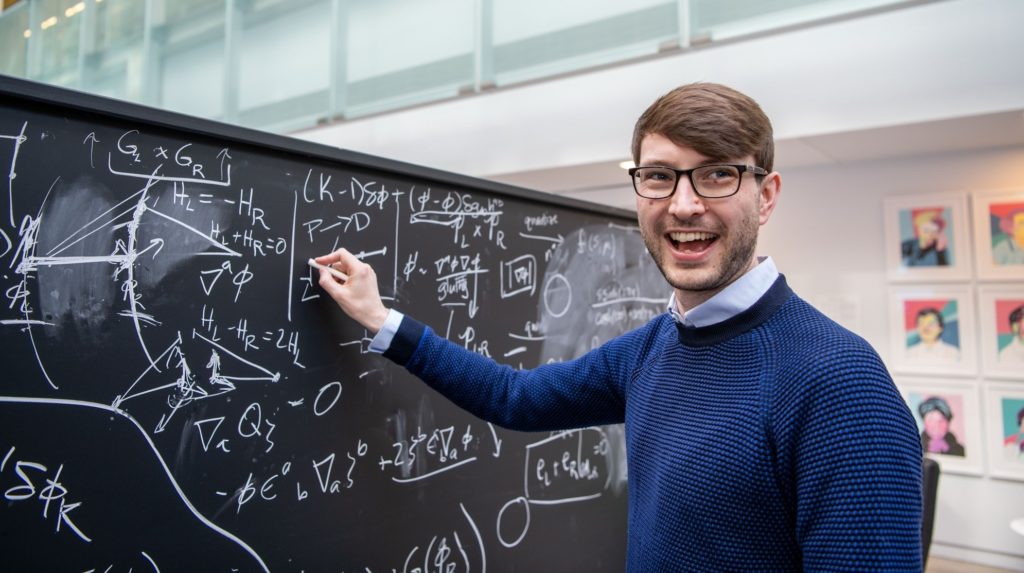How an approach from quantum physics could help save lives
“Causal inference” has been used to probe quantum systems. Now, a Perimeter graduate is exploring how it could provide insight into something more immediate: people’s health.
Take a self-guided tour from quantum to cosmos!
“Causal inference” has been used to probe quantum systems. Now, a Perimeter graduate is exploring how it could provide insight into something more immediate: people’s health.

When doctors diagnose patients, they usually start with symptoms and work backward to a probable cause, relying on both their medical knowledge and their understanding of cause and effect.
Despite the significant advances of modern medicine, diagnosis remains an imperfect process, and a potentially dangerous one. The World Health Organization estimates that hundreds of millions of people each year experience diagnostic errors in their primary care; most people, the organization notes, will receive a misdiagnosis at some point in their lives.
At best, diagnostic errors can delay proper treatment. At worst, the result is catastrophic. A tool from quantum information theory called “causal inference” could prove useful in the bid to curb the damage of misdiagnosis.
That potential was already gaining interest before the COVID-19 pandemic dramatically raised the stakes on diagnosis and treatment. Now, causal inference is one of many tools from across the science-math spectrum being assessed for potential use in healthcare and disease control, both now and in the future.
For one young Irish researcher, Ciarán Gilligan-Lee, the potential for theoretical physics to tangibly improve healthcare was so clear that, a few years ago, he staked his career on it.
“Causality is so central to science. It’s how we first learned about the world – by interacting and probing it,” Gilligan-Lee said during a visit to Perimeter Institute earlier this year. “I thought that these causal inference tools might be important, so I wanted to find a way to try and use them.”
The complexities of cause-and-effect
When two things are seen to be correlated – that is, a variation in one of the quantities is linked to variation in the other – it can be tempting to imagine that one determines the other. But the true source of the connection can actually lie much deeper, in an unseen common cause that determines both.
Causal inference has emerged over the past 40 years as a way to tease out these complex, underlying connections. For a long time, the specialty was the realm of philosophers, statisticians, and computer scientists. In recent years, it has garnered increasing interest from other specialties, most notably artificial intelligence and quantum information (as explored in this article about recent work from Perimeter Institute).
When talking about causality, one enters a realm of nearly endless probabilities. For quantum physicists, that feels just like home.
The sophisticated tools that quantum physicists develop to understand connections in quantum systems can, it turns out, also be used for data analysis and causal modelling in other systems. They are particularly useful in big data sets where causality is murky – from epidemiology to economics.
Gilligan-Lee first encountered causal inference while he was a master’s student in Perimeter Institute’s Perimeter Scholars International (PSI) program in 2012, working with Faculty member Rob Spekkens. Gilligan-Lee kept pursuing quantum research through a PhD at Oxford and a sizeable research fellowship at University College London.
But in 2018, he hit a critical decision point: he was offered a tenured position at a prestigious university. The door was wide open to a long career in academia, but if he walked through, Gilligan-Lee knew the door would close on something else, an opportunity that he suspected could change lives.
Betting it all on quantum theory
Instead, he went knocking on the doors of industry, hoping to find immediate application for skills rooted in quantum theory. He landed at the medtech company Babylon Health, which uses a chatbot-based app to suggest if someone should see a doctor. (Babylon Health recently released a product to help with the coronavirus crisis; Gilligan-Lee was not involved in its development.)
Gilligan-Lee now leads a small research team putting causal inference to work in the diagnostic process. So far, the team has published five research papers. One paper, accepted to the proceedings of the AAAI Conference on Artificial Intelligence, turned a number of heads. (Conference proceedings play a similar role in AI research as journals do in physics).
In that work, “Integrating Overlapping Datasets Using Bivariate Causal Discovery,” Gilligan-Lee and co-author Anish Dhir used tools based in quantum cryptography to suggest a way to determine causal relationships in data sets that have some common variables (that is, some of the data overlaps), but don’t exactly match. It’s just the kind of messy, real-world data that would come up if you tried to compare different medical trials.

In 18 months, the team has also developed a new causal inference approach to diagnosis and showed how it can reduce Babylon Health’s relative error rate by almost 30 percent. It’s a relative change, Gilligan-Lee notes, so it sounds bigger than it is in practice, but it is a good sign that causal inference could have tangible impacts on human health.
“Just looking at correlations doesn’t tell you that that treatment is good for recovery. You need to understand it in some kind of causal way to truly make intelligent and safe healthcare decisions. Healthcare’s all about cause and effect,” Gilligan-Lee said.
“There’s very few other companies that have this kind of fundamental research going on, with causal influence as well as the practical applications. There’s a lot of people in academia doing this work, but not a lot of it has been applied in the real world.”
Tracing it all back to one decision
Choosing Perimeter Institute’s PSI program was, in retrospect, a key factor in Gilligan-Lee’s career. “Perimeter is an incredible setup – it’s not like anywhere else in the world,” he said.
“[PSI] was more about trying to answer questions in a collaborative way – not for the sake of getting a grade but for the sake of understanding. It showed me the way physicists work. Looking back on it, I think doing PSI was one of the best decisions I made – mainly because of the people I met here.”
Perimeter already punches above its weight when it comes to causal inference. The global community is growing, too, within theoretical physics as well as machine learning, artificial intelligence, and more.
The current health crisis is helping define just how much impact this could have. One UK team has issued a paper exploring the role causal models could play in assessing COVID-19 responses around the world. Causal inference tools could also prove useful in designing and analyzing controlled trials to find a vaccine.
While Gilligan-Lee isn’t involved in those efforts, he feels the pull to take ideas that were long seen as abstract and apply them in all-too-human contexts.
“In some sense, these ideas about causality were originally from philosophy. But now we’re kind of understanding that they’re really practical in the sense of they can actually quantifiably improve people’s lives,” he says.
“Having the ability to do the research and seeing it actually work its way into the real world and have an impact is quite a cool thing.”
Researchers Robert Spekkens and Kevin Resch are interrogating the nature of causality in quantum mechanics – and the fusion of theory and experiment is helping solve some long-standing puzzles at the edge of known physics.
A round-up of the latest news from Perimeter, a look at the recent work of researchers and alumni, gems from the archive, and fun physics for everyone.
Heartfelt farewells and reflections on achievements make for a moving ceremony as this year’s Perimeter Scholars International (PSI) master’s graduates set out to make their mark.